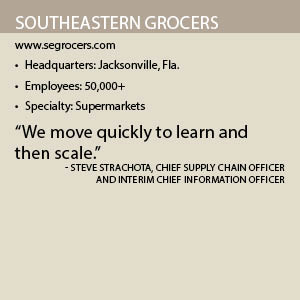Southeastern Grocers
Southeastern Grocers is adapting its supply chain to become more agile and responsive to its customers’ demands.
By Bianca Herron
Southeastern Grocers (SEG) aims to become the preferred neighborhood grocer for the communities it serves. As the fifth-largest conventional supermarket in the United States, the Jacksonville, Fla.-based company is making an impact by providing locally, relevant products at a great value through its four distinct banners: BI-LO, Fresco y Más, Harveys Supermarket and Winn-Dixie grocery stores.
BI-LO, Fresco y Más, Harveys Supermarket and Winn-Dixie are well-known and well-respected regional brands with deep heritages, talented and loyal associates, and strong commitments to providing the best possible quality and value to SEG’s customers.

According to Chief Supply Chain Officer and Interim Chief Informational Officer Steve Strachota, SEG is adapting its supply chain to become more agile and responsive to its customers’ demands. Strachota joined SEG two-and-a-half years ago to help lead the improvement efforts of the company’s supply chain, including strategic sourcing, space planning and store resets, demand planning, quality and distribution.
“I have also helped with the roll out of our new 23-store Fresco y Más banner and expansion of Harveys Supermarket to 80 stores,” Strachota says. “SEG appreciates the interconnectivity of the supply chain and the importance of viewing the work end-to-end.”
Strachota is responsible for how SEG sources, moves and plans for products. “That also includes how SEG sets the store’s spaces to improve product availability and reduce hours required to stock the shelves,” Strachota explains. “Seeing the entire playing field allows us to make tradeoffs in one area to benefit the company as a whole.”
Making It Happen
SEG has three main focus areas to improve the performance of its supply chain: efficiency, freshness and availability. “The supply chain is a cost center and the more efficiently we can move product directly results in lower costs and better prices for our customers,” Strachota says. “We work hard to eliminate waste and find areas to maximize efficiency.”
He notes that by working closely with its distribution partners, including C&S, SEG has reduced warehouse damages and the cost of outdated product by more than 60 percent in two years. “Additionally, we’ve adjusted our delivery schedules and frequency to eliminate more than 1 million miles per year, saving money and reducing our environmental impact,” Strachota says.
SEG is passionate about providing its customers the freshest products, which requires close management of the entire value chain, he adds. “I tell my team the freshest peach is the one you pick from the tree,” he says. “Our supply chain should be trying to replicate this in everything we do. Starting from the fields, we have worked with suppliers to add a harvest date to our packaging so we can accurately track a product’s age as it enters our distribution.”
In addition, SEG has updated its quality processes using tablet interfaces with its merchandising partners to communicate and track quality specifications. “We have also moved to a pick-to-zero process in the warehouse to ensure we do not keep key items like milk and bagged salads in the warehouse for more than 24 hours,” Strachota says. “Finally, we closely control our cold chain by measuring inbound, warehouse and outbound temperatures to prevent premature aging.”
SEG’s focus on availability requires a “massive effort” to ensure the company maintains more than 30,000 products on its shelves at any time. “This particularly includes promotions, seasonal fluctuations and things like hurricane preparations,” Strachota notes.
He adds SEG has embraced technology to help improve forecasting and has also improved processes in its stores to ensure accurate inventories and improved stocking regimens.
“Working closely with our merchant teams, we have also redesigned store layouts to improve shelf-holding power – especially during hot promotions and holiday rushes,” Strachota says. “These steps have led to a two to three percentage point improvement of on-shelf availability over the past year.”
Strachota adds that he is most proud of SEG transforming its business to better meet the needs of its customers. “The pace of change is incredible,” he says. “We move quickly to learn and then scale. Our people are resilient and committed to making SEG a leading neighborhood grocer in the areas where we operate.
“Southeastern Grocers intends to continue growing organically through continued growth within our existing stores, by making smart capital investments through our store remodel program and by opening new stores where it makes sense,” Strachota concludes.